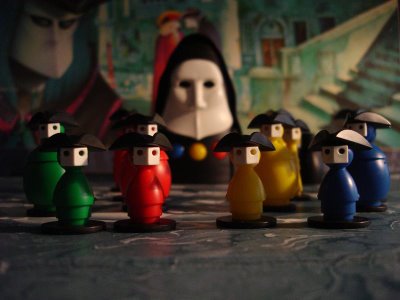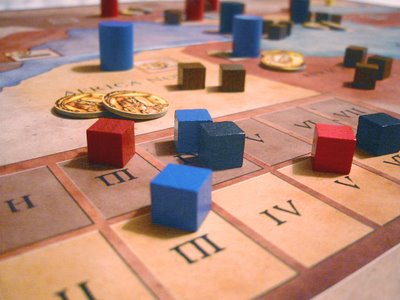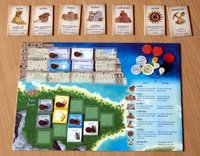Antiquity

Antiquity is one of those games that I didn't think I would ever play, or even read about. Games with a billion tiny cardboard bits just turn me off, even if they might be good. I had to opportunity to play someone else's copy and be taught to play without having to read the rules myself. In this case, it was a good thing.
This was the first play for 3 of us, and the second play for the teacher. We stopped after about 3.5 hours. At least 1 player (myself) was surely dying. At the end of each game when you are supposed to check victory conditions, the mantra, "Did anyone win yet?" was always a huge laugh since, "Did anyone die yet?" was always more appropriate.
Antiquity starts off as multi-player solitaire. Each player gets a city and some wood, and tries to build up the internals of his city as well as exploit the land around it. The city-building part requires resources to purchase buildings (shaped like various Tetris pieces), and working to occupy them (if you want their power active this turn). The resource gathering part requires you to use certain buildings in your city to initiate the actions of gathering wood, fishing, farming, and mining.
As your "zone of control" grows, you eventually run into the other players' areas and begin to compete for space. If a player has a Market, he can trade with others or with the game itself.
To win the game, you need to set your own victory conditions by building a Cathedral and choosing your patron saint. Each saint grants you some extra power and determines what you need to do to win.
The nasty part of the game is famine and pollution.
A famine track determines the amount of food you need to have each turn. For each food you are short, you must add a Grave "building" to your city. This can quickly use up space, preventing you from building other things. You can mitigate the effects of famine with some buildings, or simply by creating lots of food resource types. When we stopped playing, my city had all but 3 spaces covered with Graves. I even had to cover most of the buildings I had already built.
Each city creates 3 Pollution each turn. These markers must be placed somewhere in your own zone of control. This means you are not only draining the land of resources by harvesting them, but are also making some areas of land unharvestable. Pollution can also be mitigated a bit.
We all felt that we were trying to solve the puzzle of survival. On turn 2, I sat there thinking, "What possible sequence of building can I execute in order to survive at all?" In Puerto Rico or Caylus, you can basically play randomly; you will never die; you just won't win. In Antiquity, if you aren't extremely careful at every step of the way, you fall into a downward spiral of attrition and lack of space.
Despite the unforgiving design, I found myself trying to figure out how to live at all. I assume it's possible. I don't think it will ever be a top game for me, but I'm keen to try to survive next time.
Physically, the game is a huge pain in the ass. The smaller counters are maybe 8mm square. If you create a woodcutter in an area of solid forest hexes, you place 7 tiny field hexes over the woods hexes, then 7 wood resources counters on them, then your cube. If you farm in a similar area, you place 7 pollution counters, then 7 food counters, then your cube. Then when you harvest, you have to pick up 1 of these counters without messing up the board.
The other physical issue is that the colors of the cardboard Cities and Inns are so hard to see amongst all the clutter that you can't easily tell what's what.
If I loved this game, I think I'd replace a lot of the tiny counters with colored wooden discs. Fortunately, I do not love it. At this point, I am just curious.
Antiquity image by xtrixsterx














